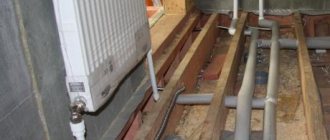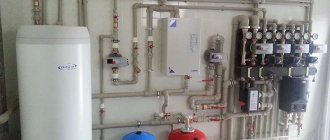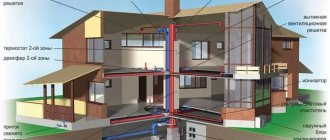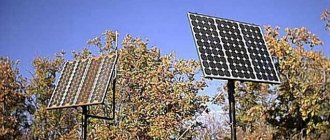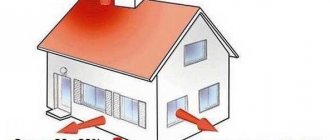Heating is the most important task that the owner of an individual home must solve. Even if professionals are involved, the owner is responsible for choosing a heating scheme in his private home, the type of connection, purchasing components, coordinating and obtaining the necessary permits from government agencies.
And also many other issues that you will have to delve into. This article will help you with this.
What warms us
Situations when you have to install a heating system may be different. Construction of a private house, transition from a stove to a more modern method of heat supply, heating of an already constructed building. Perhaps you wanted to do as much as possible without outside help and do the heating yourself.
Either way, the first step is choosing the type of heating for your home. Simply put, you need to decide what will heat you: water, air, steam, electricity?
Almost any scheme is based on the movement of a substance (coolant), which, when heated, releases heat into the atmosphere and heats the room. The center of the heating system is the boiler. Models are available that run on liquid, solid fuel, gas, or from the mains.
Boilers vary in power, type of fuel and, accordingly, cost. In addition, they are distinguished by work functions. Some are for heating only, others also provide hot water.
Radiant heating system is the optimal solution
Diagram of a radiant heating system.
Anyone who owns their own home naturally wants to organize an optimal good heating system with their own hands. He must know for sure: the ideal heating system has not yet been invented, so he must choose what is most practical and has received positive approval. You can give your preference to the heating system, nicknamed radiant. Its romantic geometric name is quite understandable: every radiator has its own beam penetrating as a pipeline.
If the owner owns a cozy, not very massive house, consisting of two floors, then the scheme for constructing a heating system using collectors assumes the presence of its own collector on each floor. They are combined in a parallel way, then a boiler is installed, then an expansion tank. This heating system is sometimes called a two-pipe heating system. And it is right. A pair of pipelines runs through all the rooms that need to be heated. One line of pipes is created for the direct movement of the coolant fluid, the other is responsible for the way back.
Heating with water
This is the most affordable and budget way to heat your home. The vast majority of owners install it.
The water heated by the boiler moves through the pipes (by gravity or under the pressure of a circulation pump), disperses through the rooms, and is supplied to the radiators. Cooling down, it returns back to the boiler.
When only heating of the house is needed, a single-circuit heating circuit is installed; for heating and hot water production, a double-circuit heating circuit is installed.
The second option also requires the use of a double-circuit boiler. For water heating, an expansion tank and drain are required. They will ensure trouble-free operation of the system.
Connecting radiators to the system
After the pipe routing method has been chosen, heating batteries are connected to the circuit; the circuit also regulates the connection order and the type of radiators used. At this stage, the heating scheme for a three-story building will not differ radically from the heating scheme for a high-rise building.
Since the central heating system is characterized by stable operation, versatility and has an acceptable ratio of temperature and pressure of the coolant, the connection diagram for heating radiators in an apartment may involve the use of batteries made of various metals. In multi-storey buildings, cast iron, bimetallic, aluminum and steel radiators can be used. which will complement the central heating system and provide apartment owners with the opportunity to live in comfortable temperature conditions.
Single pipe system
The heating system of a country house can be seen in the photo in our gallery. So, when considering the single-pipe version, you can notice that the system is of a closed type, all pipes are looped, and radiators are connected in series.
A simplified common type of connection between a pipe and a radiator is horizontal bottom wiring. Even a non-specialist can handle it. But there is a serious disadvantage with the single-pipe method. Hot water heated by the boiler, passing through each radiator, is gradually cooled. The farther from the boiler, the less heat the battery gives off.
You can improve the situation by increasing the number of sections in the radiators of the last rooms. Where the least heat comes in.
Including a circulation pump in the circuit will also reduce heat loss. This device creates pressure in the pipes, causing hot water to flow through the pipes at a higher speed and reach the last room before it has time to cool. But the pump itself is not a cheap purchase.
Stages of connecting central gas heating
- The first thing you do is buy a boiler and gas stove. Since during design you will be asked for the equipment model.
- You order and pay for a gas heating project from the city gas service. Wait for it to be approved.
- After approval, you will equip the premises. Install ventilation, boiler and heating system.
- The gas service is installing pipes. He brings them to the house and installs the meter.
- The gas service supervisor and fire inspector check the work performed to ensure compliance with all requirements.
- You enter into an agreement with the gas service to service the boiler and stove.
- The gas is being started.
Two-pipe scheme
Has no disadvantages as described above. Here, hot water moves through one pipe, and cooled water returns to the boiler through the other. Both pipes are connected to each battery. The thermostat makes it possible to supply as much heat to the room as you want.
However, the increased pipe consumption with this option makes it quite expensive. Pipes are connected to radiators in a vertical, horizontal and diagonal way.
Alternative types of heating systems
Gravity heating scheme.
Innovative methods of heating private houses are distinguished by safety during operation, efficiency, and compactness.
New heating systems for individual suburban housing allow you to change the power of heating devices in the system according to the wishes of the owner.
New heating systems use high-quality pipelines of a new generation, updates in system wiring, which improve economic performance.
Avant-garde heating systems are designed in such a way that it is possible to adjust the supply of coolant to actual weather conditions and taking into account the time of day. New heating systems provide for the installation of special regulators with a timer, which is programmed to automatically turn on/off to maintain the set temperature at night. Thermostatic valves are installed on radiators to regulate the temperature in each room of a private house.
Alternative and economical heating systems include:
- heating using solar energy;
- Heat pump;
- vacuum solar collectors;
- heating using propane-butane;
- infrared heaters;
- film radiant electric heaters - PLEN;
- heating system "Smart Home".
Wiring using a collector (beam)
You will need to buy a collector that distributes the coolant through the pipes. Installation of the circuit is a matter for qualified specialists.
The circuit allows you to regulate each battery, which means you can supply heat to the room individually. Disadvantages: high cost of the collector, pipe costs.
Video about alternative heating sources
Video about making a wind generator with your own hands:
Video about combining alternative sources to generate electricity in a small country house:
A short video about using a heat pump:
It is quite possible to abandon traditional heating sources. To do this, you need to carefully select an alternative or combine several, based on the characteristics of the area, the area of your country house and the local area. The energy of the sun, earth, wind power, and the disposal of household waste of plant and animal origin are quite capable of becoming a worthy replacement for gas, coal, firewood and paid electricity. published econet.ru
What are the disadvantages of water heating?
In addition to heat loss, with some connection schemes, the disadvantages of a water heating system include the use of a large number of pipes, which cannot always be hidden. This is a problem if a designer interior is planned for the house.
The costs of purchasing radiators and a circulation pump (with a forced water flow scheme) are significant. A significant disadvantage is that when extremely low temperatures occur, the water in the pipes will turn to ice. The pipes may simply burst.
When draining water from the carrier, as a rule, an air blockage forms there, which will have to be removed by blowing.
Water heating is a good choice for a small one-story house with an area of up to 100 sq.m. with ceilings up to 3 m high. For houses of large area, as well as for rooms with poor or absent thermal insulation of walls and floors, it will be insufficient. For a comfortable stay, you will have to use additional heating methods.
Installation of an electric water heating boiler
Choosing an electric unit for heating an apartment eliminates such significant problems as designing and coordinating a connection to the gas main, installing and maintaining a chimney, preparing firewood, and so on.
Important! Supervisory authorities do not regulate the installation of a water heating boiler when installing a heating system. But, if the boiler’s power is significant, and the volume of energy consumption may exceed the limits indicated in the contract, its operation will still have to be agreed upon with the electricity supplier.
Electric boilers are classified according to the method of converting electricity into heat:
- heating elements;
- electrode;
- induction
Having studied the characteristics of each type, they select a unit and, without wasting time on obtaining technical specifications, install the heating system in the apartment in accordance with the technical documentation of the boiler, as well as the requirements for the safe operation of electrical appliances.
Electric boilers are quite compact for an apartment and in most cases are made in a wall-mounted design, but the wall must still be strong enough to install brackets on it and then place the unit.
To connect the boiler to the electrical network, a separate line from the electric meter is installed, which is equipped with automatic switches for emergency or scheduled de-energization of the equipment; the same circuit breakers serve as fuses in the event of a short circuit.
Units with a power of up to 9 kW can cope with the heating task in a 2-3-4-room apartment, and they can be connected to a single-phase network. More powerful equipment is produced three-phase.
Ensuring the safety of the electric boiler
When using electric heaters in a water heating system, there is a risk of the coolant boiling, so when installing equipment, special attention is paid to the thermostat - a device that automatically turns the boiler on and off. The thermostatic device can also operate in circuit defrost protection mode when water heating is used as a backup heating method.
The electric boiler is also equipped with other protective devices:
- valve for automatic bleeding of air from the circuit;
- membrane valve for relieving water pressure in the system in case of failure of the thermostatic device or clogging of the pipeline;
- pressure gauge and thermometer - for visual monitoring of the state of water in the working fluid circuit in the circuit.
These devices are mounted separately or compactly assembled into a so-called safety unit.
The heating system must have a connection to the water supply, providing the ability to replenish the amount of coolant in the circuit. The connecting jumper is equipped with two ball valves with a filter between them. Phosphate salt is used as a filter element, which prevents the deposition of salts on the walls of the circuit and heating elements.
It is possible to connect an electric boiler to a heating circuit on your own, but if there is no practical experience in performing this work, it is still better to do it together with a professional, or completely trust a specialized installation organization.
Heating circuit installation
The design of the heating system in the apartment contains all the necessary information for laying out the heating pipeline with radiators. The material of the pipes, the number and location of radiators are indicated based on the calculations performed and, in the case of connection to a heating plant, the characteristics of the coolant.
This type of work when equipping a home with heating also has many features and requires not only theoretical knowledge, but also practical installation skills.
If the explanatory note for the heating project is completed at the proper level, then the pipeline layout is quite doable on your own, paired with an experienced mentor.
If there is no experience in performing these works and a specific presentation of technologies in the note, it is better to entrust the installation to specialists.
Heats by steam
The operating principle is similar to water heating. But instead of water, steam passes through the pipes. This type of heating was extremely popular just a few decades ago. But now they hardly use it. First of all, due to the high risk during operation. Heating devices used in this scheme become very hot. In case of accidents of steam equipment, people nearby receive severe burns.
Popular makes and models
A solid fuel boiler, a unit, is quite complex and can be manufactured independently. Especially when it comes to a fluid circulation system, which may simply not work due to several errors in the calculations.
Therefore, you can safely turn to reliable suppliers of such equipment, who will provide their products, plus they may offer a discount on installation and maintenance. The most popular are the following manufacturers:
- Zota.
- Pereko.
- Buran.
- Wiessman.
- Stropuva.
- Hayestechnic.
Photos of solid fuel boilers from these companies can be found below.
Heat from the air
The air heating system also uses the principle of coolant movement through dedicated channels. The air heated by the generator goes through a pipeline (air duct). The air heating system includes a fan. It moves the air flow.
The operation of such a system does not depend on changes in air temperature. It is not afraid of corrosion, leaks and ruptures. The system itself is effective in heating large areas.
In addition, it is safe to use. Therefore, it is often installed for heating warehouses, production workshops, shopping centers, etc.
Recently, it has become popular among owners of spacious private houses. The main disadvantage is that the air ducts “eat up” a considerable area of the room, and high-power generator models make noise when operating. Therefore, they require installation at a considerable distance from residential premises.
The generator itself operates from an electrical network with a three-phase stable voltage. This cannot always be provided by the energy systems of rural areas and small Russian cities. Over-drying of air is also one of the disadvantages of this system.
Keep in mind that if the generator is turned off in an emergency, the room will quickly become cold. Indeed, in this case there is no effect of thermal inertia, unlike a slowly cooling liquid. But a low-power generator without a fan is quite enough to heat a two or three-room house.
Features of using vertical distribution of heating pipes
The vertical organization of the heating system involves connecting all used devices to the main riser. Each floor is connected to the general system separately. During operation of this system, air pockets almost never form.
When operating a heating system made of two pipes with overhead wiring, you can create various installation schemes. These diagrams will vary depending on the location where the expansion tank is located, taking into account the height from the floor.
An organized system can contain pipes of various diameters, since the top point of the pipe responsible for supply is located at the beginning of the distribution.
The main components of vertical heating distribution
The vertical type wiring scheme currently prevails in residential buildings. The most commonly used heating system is two pipes. One of the pipes serves for direct heat supply, and the other for reverse heat supply. Such systems usually consist of the following elements:
- Pump;
- Batteries;
- Boiler;
- Tanks;
- Temperature pressure gauge;
- valve;
- Valve fuse;
- Thermostatic valve;
- Air vent;
- Balancing device.
Advantages of organizing vertical heating from two pipes in an apartment
A vertical heating system is used in rooms where a unified accounting of heat consumption is maintained. In such systems it is impossible to install individual meters. The use of wiring provides the following advantages:
- Convenient adjustment of the heating system;
- Possibility to turn off autonomous heating elements;
- Possibility of connecting a system of two pipes floor by floor;
- Elimination of the possibility of overconsumption of heating devices;
- Relative cheapness of installation of systems;
- It is possible to regulate and prevent noise generation;
- There is no need for expensive adjustment of the heating system;
- Good system stabilizers in the long term.
How is a heating radiator replaced for a vertical system of two pipes?
It is always better to entrust work related to the heating system to an experienced specialist. This will ensure excellent results, get results in the shortest possible time and save money. All experienced craftsmen have already developed an algorithm of actions for carrying out installation work. We can highlight the main points of carrying out work with wiring of two pipes:
- Minimizing violations of the installation scheme to eliminate problems with the heating network;
- Using the services of a welder when replacing a radiator for a two-pipe system;
- Only polypropylene is used for heating the headquarters;
- To properly organize installation, it is best to calculate the pressure exerted on the pipes in advance.
Replacing water with electricity
The second place in popularity among autonomous heating systems is occupied by various electrical appliances. This heating method can be main or auxiliary. It is usually chosen when there is access to cheap electricity (unauthorized connection), there is no main gas pipeline, and for some reason it is not possible to use gas cylinders for heating.
The arsenal of electrical appliances is extremely diverse. You can choose equipment that suits your heating needs, house area, and financial capabilities. Those who have resorted to electric heating use convectors, film systems, infrared ceiling heaters, all kinds of thermal panels and curtains (combined type).
Often in articles similar to this one, an electric boiler is mentioned in the list of other electrical equipment. In this case, this is not entirely true. Even if the boiler starts working from the mains, it will still heat water or air.
The principle of electric heating is that when heated, the surface of the heating device begins to reflect heat. Or produce special rays that circulate in space and heat the room.
Warm floor
At first glance, this is a very smart solution: heating occurs from the lower boundary of the room, which ensures excellent convection and uniform heating.
However, laying heated floors is a rather labor-intensive process and requires special skills.
Do not forget that it is not always possible to lay screed under a heated floor - it depends on the load-bearing capacity of the beams and the first run in each particular house.
- How to fix a laptop that won't charge
- Insulated dielectric screwdrivers up to 1000V - tips on how to choose the best manufacturer
- Dielectric insulated tool for work - which one is better to choose? Review of manufacturers, photos + video
Infrared radiation in service
The action of long-wave rays is similar to sunlight. Devices operating on their basis consume much less electricity than all other types of heaters. The infrared heating panel is mounted to the ceiling.
The main thing when using this system is to carry out the electrical wiring correctly. Often such panels are used as an additional means of heating a home.
How to install an air system
These systems require careful heating calculations, so you will need some special tools or specialist help.
Such a system needs to be installed in stages, that is:
- Select the type of system.
- Carry out the necessary calculations.
- Acquisition and preparation of all system elements.
- Install air heater systems.
- Connect all elements of the system, while creating comprehensive ventilation of the room.
The boiler is the basis of everything
This is the main component of most heating systems. To avoid many mistakes, take his choice seriously. This is the case when the stingy pays twice. If you want to save money and purchase a boiler of insufficient power, you will doom yourself and your household to a chilly life. You will have to use additional heat sources, which will lead to unnecessary expenses.
Boilers are distinguished by the type of fuel that, when burned, heats the coolant, as well as by power. The efficiency and safety of the boiler operation is important. Ease of use. Quiet operation.
The design of all boilers is, in general, the same. Consists of a combustion chamber and a heat exchanger. The first contains fuel raw materials, the second serves to heat antifreeze or water.
You will have to immediately determine whether you need a boiler only for heating. Or with an additional function for producing hot water. This problem is solved by a double-circuit boiler.
The boiler installation location must be spacious, bright and dry. Usually, a basement is used for these purposes or a separate room is built - a boiler room.
There should be no difficulties connecting the necessary communications to the boiler. If you are using a boiler that runs on coal or wood, provide a place for storing raw materials. A chimney is required.
The issue of ash disposal will have to be resolved. If liquid fuel boilers are used, find a large container for storing diesel fuel and place it safely, away from sources of open flame. On the heating equipment market you can find modern models that run on fuel oil, light grades of oil and even waste engine oil.
To change fuel, just select the right burner. Electric boilers are the easiest to operate, do not pollute the atmosphere with harmful emissions, are silent and safe. The disadvantage is that electricity tariffs are increasing every year. In this sense, a gas boiler is much more economical.
Selecting a boiler by fuel type
Boilers are divided by type of fuel. The following types of boilers exist:
- Gas;
- Solid fuel;
- Electrical;
- Liquid fuel;
- Mixed type.
When choosing a fuel type, you should first of all focus on the availability and uninterrupted supply of coolant. If you are attracted to an electric boiler, and there are frequent power outages, you should choose a different type. Otherwise, you can freeze yourself, damage the equipment, and in some cases, damage the repairs.
Gas boilers
It is no coincidence that they are considered first. This type of fuel is more accessible, for this reason it is most often used when installing heating.
There are two types of gas boilers:
- Floor view
A more powerful, easier to install type of gas boiler. Can work in any type of heating system. Non-volatile, do not require connection to electricity.
- Wall view
Not as powerful, but more compact. Due to their good appearance, they can be installed in any part of the house. Most are designed for closed type heating systems. Often they have all the necessary automation included. Energy-dependent, but available for complete automation of the home heating process.
Also, wall-mounted gas boilers are divided into the following groups:
- With open or closed camera
Open type boilers require constant ventilation, since the air is taken from the room. In addition, a chimney is needed to remove combustion products. Closed boilers are more convenient for installation. In this case, air is pumped in from the street; there is no need for ventilation. To remove combustion products, there is a special outlet that is not difficult to install.
- With one or two circuits
A single-circuit gas boiler works exclusively to heat the building. The double-circuit boiler also additionally heats the water. If there are more than two points of simultaneous use, you should prefer a single-circuit gas boiler with a boiler connected to it.
The choice of gas boiler type depends on its power. The larger the house, the more power will be required. Calculation formulas are often used. But in a small building with high-quality insulated walls and floors, you can limit yourself to purchasing a low-power boiler.
Solid fuel boilers
At the moment, this type of boiler is less common than the gas or electric type. Structurally, they do not differ from gas types.
Divided according to the following characteristics:
- Type of solid fuel (pellets, firewood, peat, coal). Choose the most accessible type.
- External view of the boiler. When purchasing, consider your taste and the room where it will be installed.
- Dimensions and power. Determined by the size of the room.
This type of boiler in its simplest design does not depend on electrical energy, but is dependent on people, as it requires frequent addition of fuel and regular cleaning of soot.
Like all other types of boilers, solid fuel boilers have a number of advantages and disadvantages.
Advantages
- Long-term operation is ensured by the simplicity and reliability of the entire final design;
- Low cost not only of installation, but also of the equipment itself;
- Documentation for equipment and installation is not required;
- Large assortment for a wide variety of characteristics.
Flaws
- A supply of solid fuel is required and the need to store it under certain conditions;
- The need for frequent loading of fuel makes the boiler not so convenient to use;
- The presence of soot and soot requires regular cleaning.
Modern pellet models can be additionally equipped with automatic control and automatic fuel supply. When installed correctly, such models are very reliable.
Electric boilers
If there are no power outages, you should opt for electric boilers. They are able to evenly heat the room in a short time.
According to their design, they are divided into the following types:
- Heating elements new types of boilers
They are ineffective, but they waste a lot of electrical energy. The coolant is heated with the help of heating elements lowered into it. If the coolant is liquid, the service life of the heating elements is very short.
- Electrode types of boilers
Less expensive in terms of electricity, but at the same time more reliable. The electrodes are located in the boiler. When electricity is supplied, they heat up the coolant.
- Induction types of boilers
It is the most profitable option for an electric boiler. They quickly and evenly heat the entire area of the room. The disadvantage is the high cost of electricity. This quickly pays off with automatic control of the heating system. Fully automatic boilers of this type are quite economical to use.
In addition to the above, induction boilers have additional advantages:
- Fast heating;
- Compact dimensions;
- Easy installation;
- No collection of additional documentation;
- No chimney required;
- Environmental friendliness;
- Safety.
Thus, if the building has already been built and there is no possibility of additionally equipping a ventilation system or chimney, this type of boiler will be the best solution.
Liquid fuel boilers
They have not become widespread and are used exclusively in places where liquid fuel is more accessible than other types. This can be diesel fuel or heating oil. This type of boiler is quite economical and can heat a fairly large room.
Mixed type boilers
The combined type of boilers is the most expensive heating option. Capable of operating on different types of fuel. This option is good in areas where the main inexpensive type of fuel may be supplied intermittently. In this case, the boiler switches to another type of heating. The transition is most often carried out automatically.
Need pipes
This component is an integral part of the heating system, requiring considerable investment. Pipes are distinguished by diameter and material of manufacture.
Until recently, there was little choice. All utility networks were laid with metal pipes (steel or galvanized iron). They were also used in private housing construction. Steel pipes are connected to each other by welding. Over time, these seams begin to leak water. In particularly cold winters, the steel system freezes and fails.
Galvanized pipes are much more reliable and have a threaded connection. Copper pipes are distinguished by their high durability and high price. They are not subject to corrosion, withstand high pressure well, and are connected by soldering. But, despite their advantages, they are rarely used due to price.
The modern choice of consumers, attractive for their cost-effectiveness and ease of installation, remains with pipes made of various plastics (metal-plastic, polypropylene, polyethylene). They are not expensive and do not require special knowledge during installation. Other attractive properties include: small diameter and weight, not susceptible to corrosion or clogging.
The welding method is hot pressing, which is easy to learn. The disadvantage of metal-plastic is its short service life.
After a couple of years, pipes made from this material begin to leak. The new generation metal-polymer pipe has a flexible structure, which is an advantage for installation in hard-to-reach places.
The required pipe footage depends on the heating area, the thermal insulation of the building, and the connection diagram (one or two pipe system). Pipes are laid along or inside walls and floors, at such a height so as not to damage them when fastening baseboards.
Oil radiators and heat guns
Such devices are not suitable for permanent use; they are used only temporarily and in small spaces for several reasons:
- the area of the room they heat should be small, usually no more than 20 sq. m; they are simply not designed for large areas;
- heat guns make a lot of noise and create a narrowly directed flow of warm air;
- most often these devices are not equipped with an automatic shutdown system when a certain temperature is reached;
- Oil radiators cause headaches.
Battery selection
Like pipes, radiators are made from various materials. Heavy cast iron batteries are a thing of the past. Although they are not deservedly forgotten, having several significant advantages.
For the lowest cost, cast iron stoves offer a large supply of heat and have an impressive volume. Even when the heating is turned off due to an accident, the cast iron radiators slowly cool down, continuing to perform a heating role.
However, consumers are not satisfied with the weight of these devices. Lifting and installing a cast iron radiator alone is beyond the power of one person.
In contrast, lightweight aluminum heaters have an attractive appearance. But there are models on sale with a fairly high price. Bimetallic devices have become the new generation of heaters. Their distinctive feature is an aluminum body and a steel pipe. They are also considered expensive acquisitions.
Whatever the radiators you buy are made of, they are installed the same way - under the windows, at a height of 15 cm from the floor. This is how they cut off cold air coming from outside. It turns out that there should be as many batteries in the room as there are windows in it. The size depends on the area of the window.
In the living room, to create a comfortable temperature, install radiators with seven or more sections. In houses with several floors, the batteries are placed in one riser, one above the other. Thermostats are installed at the junction of pipes and batteries.
Other types of radiators include convectors and heating panels. They were discussed in the chapters on air and electric heating.
Recommendations for chimney installation
The chimney should be installed with a minimum number of bends and turns. Since in such places a large amount of ashes and various resins will accumulate.
The pipe should be secured very securely, as it will exert strong loads, which can further damage the boiler.
It is important to select the optimal length of the chimney, only in this case there will be excellent draft.
You will need to make brickwork in the wall under the chimney outlet. This is done for fire safety purposes; the pipe is also wrapped in asbestos sheets.
About documents
Now that you understand the principle of heating in a private home, have an idea of the types of heating systems and types of equipment, you can use the most profitable and convenient heating option in your home.
All measures for installing the heating system are reflected in a special project, which is the main document for the work. It is ordered from specialized companies and approved by the administration of the settlement where you have a home.
The diagram should indicate the location of the boiler, radiators, taps, thermostats, fittings and other shut-off valves, and a detailed plan for the location of pipes. However, the project of an autonomous heating system for an individual house is not the only document that needs to be drawn up and agreed upon. Find out the specific list from the relevant organization at your place of residence.
All projects, permits and schemes are processed according to the current rates for each organization. This will become a significant part of your heating costs. However, without them, the installed system will be considered illegal, and you risk receiving a large fine. In addition, you will be cut off from all communications. Is it worth it?
How to Install an Electrical System
This type of heating has a simpler installation, but still has its own characteristics and nuances.
Such a system requires careful adherence to step-by-step instructions, which consists of:
- Selecting types of electric heating specifically for your room. The most popular are infrared heaters, air conditioning, electric convectors, oil radiator, underfloor heating systems, installation of electric boilers.
- Necessary engineering calculations and system sizing calculations.
- Installation of all system elements.
- Connecting the system to electrical networks.
- Checking the system's functionality.
It is worth noting that installation work that involves electricity is very dangerous, so you must carefully follow safety precautions.
Photo of heating a private house
Pressure in a closed system
Heating standards depend directly on the type of building for which heating is supplied. That is why each specific case must be considered separately:
- For a private home, a pressure of 1.5-2 bar will be normal. If the pressure gauge shows a high number, then this condition is considered critical. If the meter reaches 3 bar, this can lead to an accident in the system: the tightness will not withstand this pressure, and the entire structure will break.
- For high-rise buildings, external factors do not affect such a structure, then the pressure standards in it range from 8 to 9 bar. However, this is typical for new houses. Older buildings can be heated at pressures up to 5 bar.
Pressure in a closed system
Circulation pump in a closed system
Circulation pump in a closed system
Due to these structural elements, the functioning of the entire system occurs. There are models on the market of different capacities, which are determined by a combination of several factors. The size of the pipes and the material of their manufacture, the number and presence of radiators, if there are thermostatic fittings, the length of the pipes, as well as how the equipment works are taken into account.
There are standardized tables from which you can select a pump. They need to focus on the area of the room that needs heating or the power of the system as a whole - you can build on this data when searching for a suitable option.
Harness
Earlier in the article it was mentioned that pumps in a closed system are mounted on the return pipeline. A few years ago this was a mandatory requirement for installing the system, but now the owner can do it as he sees fit.
The pump is manufactured using durable materials that can withstand temperatures up to 90 degrees.
If the design operates with natural circulation, then during installation it is better to make sure that the pump in case of wear or breakdown can be replaced without removing the coolant. Ideally, the station should operate even without a pump. To implement this idea, it will be enough to install a bypass - this part allows the coolant to flow without the participation of other elements.
If you are dealing with a closed system that uses forced circulation, then a bypass will not help here. This design option cannot function without a pump. However, here you already need a filter and two taps, which are located at the inlet. With the help of ball valves, you can disassemble the structure at any time if it needs repairs or replacement of worn parts. The filter performs a standard function - it prevents the system from clogging. To further secure the system, a check valve is installed between these two parts, which closes the path for the coolant in the opposite direction.

